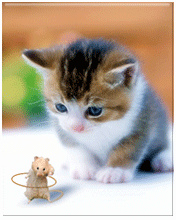
Although activists traditional painting Kamasan puppets remain strong with the standard-standard outlined his ancestors, does not mean the development of this traditional art to be stagnant or roads in place. Generation still has a roomy space to be creative and create innovations. If in the early development of wayang painting was only shown on the stretch of wood, then "crossed over" into the fabric (canvas), this time the puppet figures are even more "wild" is displayed on the stretch of animal skins, egg shells, coconut shell, bamboo, even a helmet.
Art products resulting function also varied, ranging from purses, fans, farmers' hats, ashtrays, flower pots, cow and a row rumbled goods other crafts. For convenience Kamasan village, ideas pouring out of wood and cloth media that is not a form of "betrayal" of their ancestral traditions. Media where the expression may vary, but the character, style, color and detail puppet is still subject to the standard-existing standard. "In the beginning, creation is experimental. But in its development, the type of craft that just very interested tourists, especially foreign tourists, "said I Ketut Widastra (53), the youngest son of I Ketut Rabeg, a''temperature" Kamasan puppet artist.
According to the Head of SDN 1 Semarapura Klod this Kangin, "crossing" medium of expression from wood and fabric to the other media has developed pascakunjungan Walter Spies and R. Bonnet to the village of Kamasan. According to them, so that production can compete at the global level must be able to follow the emerging trend. "People then tried to paint puppet on a Kamasan Stil fan, bamboo hats, purses and other items. Currently, the helmet was also getting to be a target, "he said.
Widastra added, the products are usually used as a souvenir by tourists. Therefore, the shape and size also created mini that is comfortable to carry. Especially for souvenir items, the price is much cheaper when compared with the paintings made over the span of wood and cloth. "When wood processing technologies become more advanced, we also make an egg-teluran of wood. On top of it and then painted with Kamasan stylishly dressed puppets. Given the limited space, we obviously can not display the epic story of the Mahabharata and Ramayana as a whole, "he said again.
Furthermore Widastra said dye is used also changed with the times. Kamasan Painting tempo first, he said, the pure-dye using natural dyes derived from fish bones, rocks, plants and ink dissolved in water (the burning of charcoal-ed). Most of the natural dyes were obtained from Nusa Penida, there is even a special imported from China. For example kencu to produce intense red color.
Color-making process also needs a relatively long time that made it less practical and efficient. If there is a large-scale orderan, Kamasan artists obviously can not fulfill. Therefore, they are forced to turn to the colors of the manufacturer (color chemistry) is easily obtained. Only, in the coloring process that most of the artists still include natural colors to maintain the natural impression. "At present, natural colors were more difficult to obtain. However, for certain orders, we still use it. Of course, the price was higher, "said a fixed Widastra took puppet Kamasan painting between busy teaching.
Men who have a show room to display works of art produced by this family confirmed, most of propriety Kamasan Village Banjar Sangging indeed dependent of the puppet art. In other words, the art of this heritage has evolved into a home industry. While access to markets, still rely on visits from tourists who come to the village of Kamasan. Very rarely specifically menjajakkan out Kamasan products. Conventional sales system like this also requires that they compete among friends. "Our income is dependent of tourist visit. In lean times like the present guest, could be a whole week we were not able to sale, "he said again.
So, what products are most attractive to tourists? According to Widastra, tourists who come can be classified into two groups, namely the true art lovers and tourists. True art lovers usually hunt paintings of fruit quality by famous artists. While the tourists tend to buy souvenirs valuable "tilted" as wallets, egg-teluran, fan and other products. "Not all tourists who come have a high art appreciation. They usually just buy regardless of who the painter. After all, the goal only to by-by and given to relatives in their home countries, "he said.
He added, Kamasan painting made famous painters such as Rabeg and Mangku Mura - two Kamasan puppet master painter - and using natural dyes and painted on cloth prices Bali can penetrate tens of millions of dollars.







Tidak ada komentar:
Posting Komentar